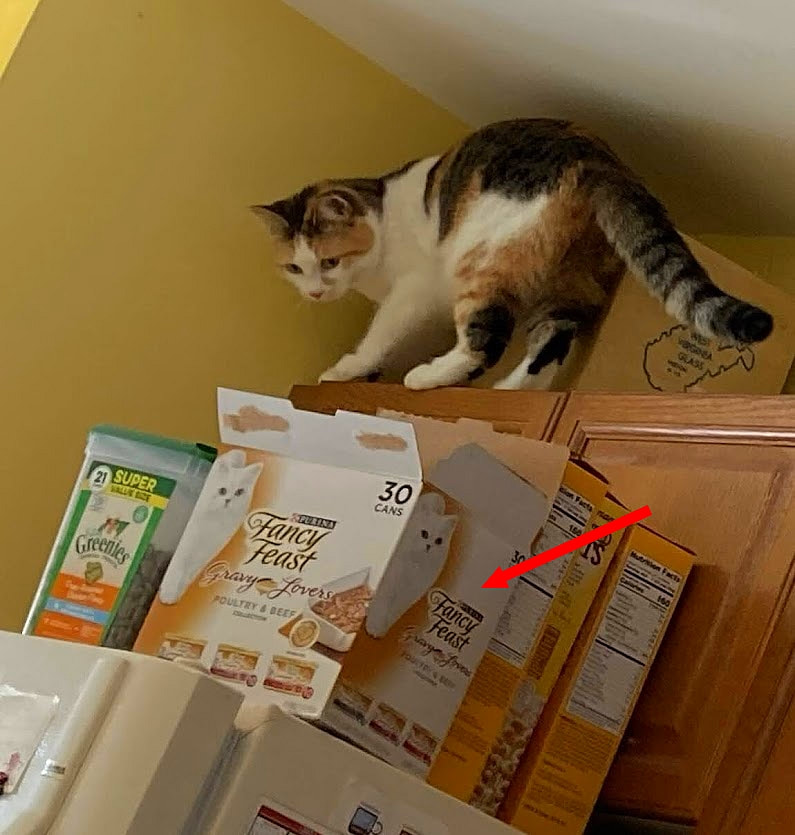|
In the image below, you can see that Science Cat is on top of the kitchen cabinets. If you go online, you can find many explanations as to why cats like high places. The main explanation put forward is that it’s an instinct. Cats are descended from tree climbing animals, which needed a high vantage point both to spot and hunt their prey and to spot and avoid predators. However, I want to propose a simpler hypothesis as shown in the image below. The images belong to the author and can only be used with permission.
0 Comments
Schrodinger’s Cat is a famous thought experiment conceived by the physicist Edwin Schrodinger who won the Nobel prize in physics in 1933. This thought experiment is meant to be critical of the so-called Copenhagen interpretation of quantum mechanics, which states that particles exist not in one state but in a superposition of possible states until they are observed. Schrodinger’s experiment linked this interpretation to a cat inside a box whose life depends on the state of a particle, leading to the inference that, until the box is opened and the cat is observed, the cat is neither dead nor alive, but both. In popular culture, Schrodinger’s Cat has inspired many stories, memes, and jokes such as: “Schrodinger’s Cat walks into a bar, and doesn’t”, or “Wanted, dead and alive: Schrodinger's Cat”. In the photo below, Science Cat does her impersonation of Schrodinger’s Cat, although she is pretty much alive! The image belongs to the author and can only be used with permission. Science cat is trying to figure out a word in a crossword puzzle. It is three-letters across, and the clue is: “a pet that kneads you”. Kneading is an instinctive behavior which most of the time indicates the animal feels secure or relaxed, although excessive kneading may indicate anxiety. The image belongs to the author and can only be used with permission. Ailurophobia is a word that has Greek roots. “Ailuro” comes from the ancient Greek “ailouros” which means “cat”. And phobia comes from the Greek “phóbos”, which means fear or panic. Thus ailurophobia is the fear of cats. I have written a blog post about the things that we fear, or phobias, which you are welcome to check out if you want to learn more about this matter. Note: the photo belongs to the author and can only be used with permission. In this photo Science Cat is checking out a chicory plant (Cichorium intybus) that we picked from the side of the road and then planted in our garden. This plant, which is native to Europe, North Africa, and western Asia, was introduced into the United States for medicinal and gastronomic reasons in the 18th century and then escaped into the wild. One interesting thing about this plant is that chicory roots when roasted taste like coffee, so they have been added to coffee in times of shortages to makes coffee supplies last longer, and in some cases replaced coffee altogether. Another interesting thing is that the plant grows mostly in disturbed sites such as the side of roads and railroads or abandoned fields, but not in undisturbed natural areas. Note: the photo belongs to the author and can only be used with permission. The photo below shows science cat doing her "cloud cat" impersonation. You can clearly see the colors that make her a calico, but you can also see the banding pattern in her fur that makes her a tabby. Note: the photo belongs to the author and can only be used with permission. We have a cat named Owl (actually, Owl Turnip, but that’s another story), and she has been designated the official mascot of Ratioscientiae.com! Owl appears here under her professional name, Science Cat. Owl was picked of the streets, so she is not of a particular breed, but she is a calico cat. A calico is not a breed of cat. A calico is a cat with a fur coat that has 3 colors (white, black, and orange). The unique color of the fur of the calico is coded for by genes present in the X chromosome, and it only manifests itself in the phenotype when two copies are present. Therefore, only females, which are XX, have the calico color. There are some male calicos, which in most cases arise as a result of a chromosomal aberration (they are XXY), and they are sterile. Owl also has stripes on one side of her body, which makes her a tabby cat. The calico cat is the official cat of the state of Maryland where Owl resides. Note: the photo belongs to the author and can only be used with permission. |
Details
AuthorWrite something about yourself. No need to be fancy, just an overview. Archives
February 2023
Categories
All
|








 RSS Feed
RSS Feed